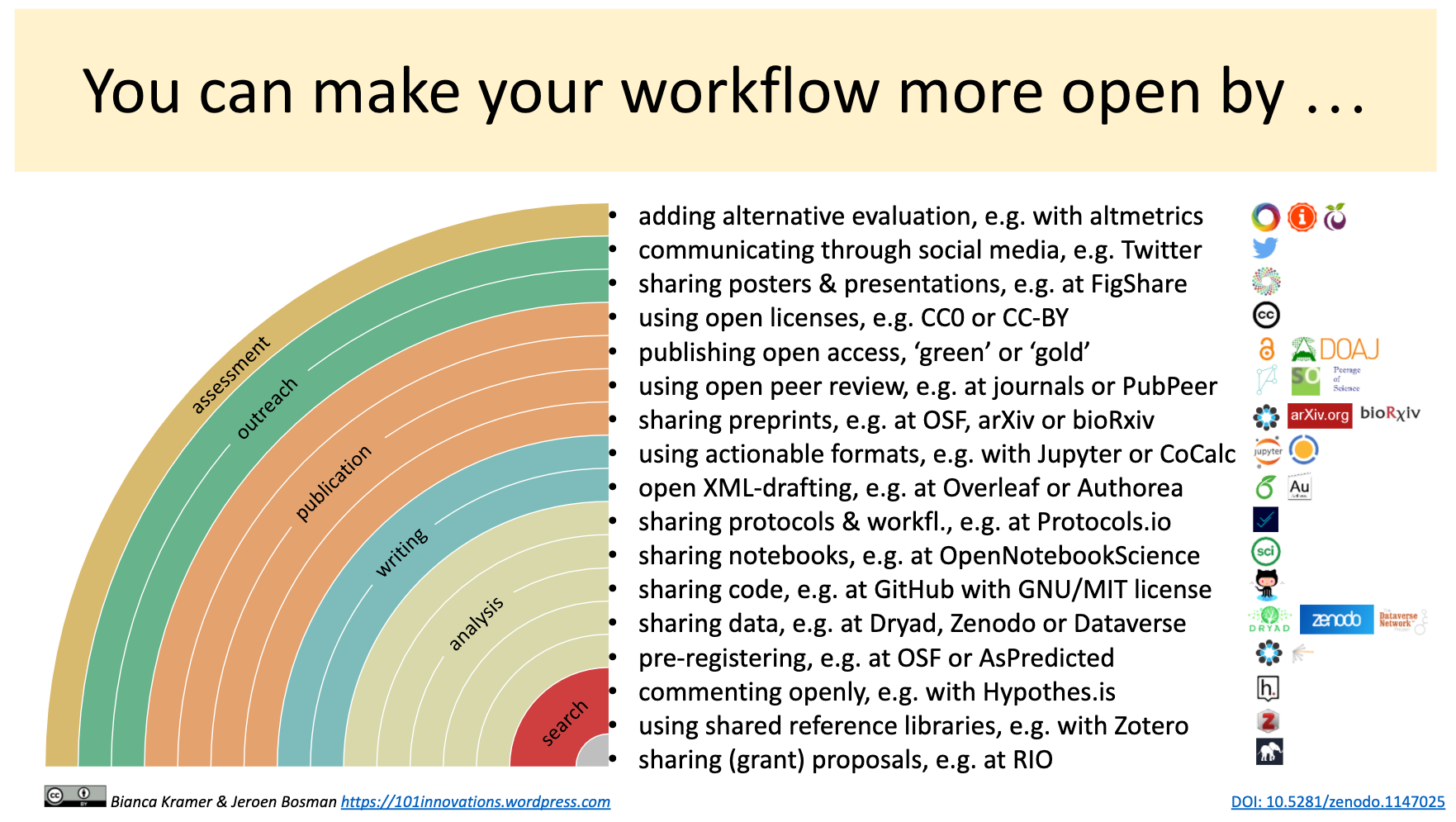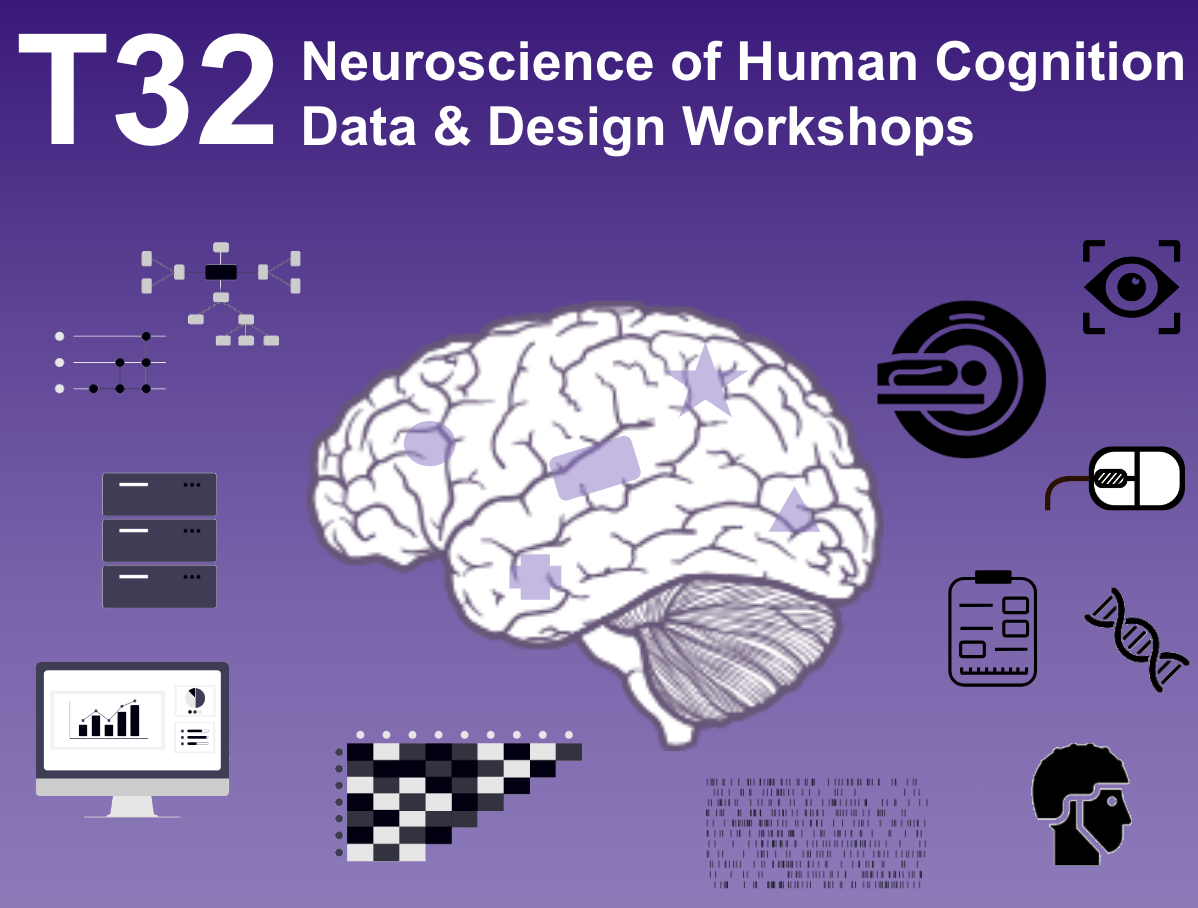Overview & procedure#
Through this initiative we aim to provide comprehensive training and support concerning all things data science/management and open/reproducible science for the Neuroscience of Human Cognition. To do so, we will follow a “learning by doing” approach in a tripartite manner. Starting from overview lectures, we will go through different tutorials and provide direct support via consultations for individuals and labs. We actively seek out realistic examples and workflows that mimic the lifecycle of real-world projects, trying to present you with both a respective overview and hands-on experience.
The three different aspects are meant to be complimentary and flexible to ideally support the T32 Neuroscience of Human Cognition community. Lectures aim to provide a holistic overview of specific topics, including motivation, impact, current state and resources, with practical advice on how to implement corresponding aspects into one’s own research workflow. Tutorials are more hands-on, either focusing on resources explored during the Lectures, more specialized topics or “bring-your-own-data” sessions. Consultations are meant to more directly support individual researchers and labs in work related to the aspects of this training initiative.
Lectures and Tutorials will be alternating on a monthly basis, with Consultations taking place whenever works best for all parties involved.
Below you’ll find an introduction slide deck, providing a respective overview.
You can directly access the slides here.
All of this following open science principles as outlined in the rainbow of open science practices below and the aim to enable you to critically evaluate scientific research. Along this way we will also talk about important topics such as #DEI and systematic biases. For a rather precise outline of the course, please consult the respective section.

The framework and setup#
All workshop materials will be provided within the Jupyter Book format you’re currently looking at, free for everyone to check and try out, as well as utilize further. The workshop itself will use a mixture of slides, code and other media within presentations, practical hands-on sessions and discussion rounds to enable a holistic introduction paired with firsthand experience. Depending on a given participant’s computational resources and infrastructure, we provide multiple ways to participate in the workshop as outlined in the Setup for the workshop section.
Instructors#
To provide a holistic introduction into the mentioned aspects and the respective subcomponents, we assembled a stellar team of instructors, i.e. the main team, as well as contributors. You can find the main team below and get further information via clicking on the respective names.
How to address one another?
When contacting us, please refrain from using titles when addressing us and super formal language, using our first names is fine and it’s way more important that the content is respectful, fair and constructive (We aim for the same when we reply). However, please let us know if you have a preferred way of interacting with other folks, including how you would liked to be addressed, your pronouns and the level of formality.
How to reach the instructors#
The contact information of the instructors are as follows:
Office hours: please contact the team member you would like to talk to via Email
E-mail: please follow the links above
preferred mode of contact: usually online to save time and effort for everyone but in-person is fine too!
Gimme the details#
Below you will find important details summarized in a compact form.
When and where#
As this won’t be a “classic” course that entails weekly lectures/assignments, etc. but instead utilizes a different outline that is oriented along the research process, we will have sessions with varying content. Combined with a strong focus on project work and direct support, we will organize some meetings as we go. Thus, please watch out for E-Mails/Discord notifications! However, we will definitely meet once a month during the CBMG hours, Wednesdays at 12 PM.
The in-person meetings will either take place in Simpson-Querrey 1M-200, Krantz
or on the Evanston Campus in yet to be set location (updates will follow soon).
Can I use my calculator?#
For this initiative you will need frequent access to a computer. None of the topics that we will be going through will be very computationally intensive, so this does not need to be a modern or “fast” computer. Still, it will need to be running a standard operating system like Windows, Mac OS X, or Linux. Unfortunately, tablets running mobile operating systems (iOS, Android) probably won’t work for this purpose. If this is an issue for you, please get in touch with the instructors as soon as possible so that we can try to figure out a solution. Regarding software and installation thereof, please check the next section.
How do I get all the software and do I have to apply for a loan to get it?#
Don’t worry at all. First, in order to help you get all the software required for this endeavor, a comprehensive installation instruction was compiled. In a step-by-step manner it guides you through the installation process, covering several OS: windows, macos and linux. Second, everything will be completely free of charge as we will only use publicly available open-source software. Why? Because supporting trainees via proprietary software is just not fair and won’t help anyone: trainees have to obtain licenses or use those from the university (which usually doesn’t have enough for everyone), leading to tremendous problems regarding inequity now and in the future. Additionally, opens-source software can do everything, if not more, what proprietary software can and is furthermore usually better supported, tested and documented, creating a fantastic sense of community.
Where is everything?#
All course materials (lecture slides, lecture demo notebooks, lab notebooks, etc.) will be available on the course website, i.e. the one you’re looking at right now. Everything will be completely open and free to use, thus constituting an open educational resource you are free to explore, enhance and share. Thus, this website and all materials will also remain up for the entire duration of this initiative and beyond, ideally to the end of the internet. The usage of this resource and the materials therein will be explained at the beginning and throughout.
Syllabus and Text#
As noted above, this page serves as the syllabus for this initiative, with the precise outline indicated in the respective sections. This syllabus is subject to change; so please have a look every now and then.
This course furthermore has an open shared zotero library where we add all articles presented/discussed.
Additional reading material might be added but will always be open & free with trainees being informed about any addition.
Participant Accommodations#
Please request a meeting as soon as possible to discuss any accommodations. Please notify us as soon as possible if the material being presented is not accessible. Please notify us if any of the physical space is difficult for you.
Code of conduct#
This course has a Code of conduct. Please inform yourself about the specifics by carefully reading through the respective section.
How to Get Your Question(s) Answered and/or Provide Feedback#
It’s great that we have so many ways to communicate, but it can get tricky to figure out who to contact or where your question belongs or when to expect a response. These guidelines are to help you get your question answered as quickly as possible and to ensure that we’re able to get to everyone’s questions.
That said, to ensure that we’re respecting everyone’s time and thus will mainly answer questions between normal working hours (M-F 9AM-5PM). The instructors are also going to do their best to stick to these working hours. However, they know that’s not when you may be doing your work. So, please feel free to post messages whenever is best for you while knowing that if you post late at night or on a weekend, you may not get a response until the next weekday. As such, do your best not to wait until the last minute to ask a question.
If you have:
questions about course content - these are awesome! We want everyone to see them and have their questions answered too, so either use the hypothes.is plugin, the
discordchannel, thee-maillist or the GitHub repository.a technical question - come to office hours (or post to
discord). Answering technical questions is often best accomplished ‘in person’ where we can discuss the question and talk through ideas. However, if that is not possible, we can schedule an in-person meeting or post your question todiscord. Be as specific as you can and help us by providing examples and code.been stuck on something for a while (>30min) and aren’t even really sure where to start - Programming can be frustrating and it may not always be obvious what is going wrong or why something isn’t working. That’s OK - we’ve all been there! IF you are stuck, you can and should reach out for help, even if you aren’t exactly sure what your specific question is. To determine when to reach out, consider the 2-hour rule. This rule states that if you are stuck, work on that problem for an hour. Then, take a 30 minute break and do something else. When you come back after your break, try for another 30 minutes or so to solve your problem. If you are still completely stuck, stop and contact us (office hours, post on
discord). If you don’t have a specific question, include the information you have (what you’re stuck on, the code you’ve been trying that hasn’t been happening, and/or the error messages you’ve been getting).questions about course logistics - first, check the overview. If you can’t find the answer there, post on
discord.something super cool to share related to the content or want to talk about a topic in further depth - feel free to post on
discord, contact the instructors or come to office hours.some feedback about the initiative you want to share anonymously - If you’ve been offended by an example, really liked or disliked materials, or wish there were something covered that wasn’t but would rather not share this publicly, etc., please fill out the anonymous Microsoft Form
*This form can be taken down at any time if it’s not being used for its intended purpose; however, you all will be notified should that happen.
Acknowledgements#
Several parts of this section are directly taken or adapted from Alexander Huth’s Neuro Data Analysis in Python syllabus licensed under a BSD-3-Clause License and Shannon Ellis’ COGS 18: Introduction to Python.




